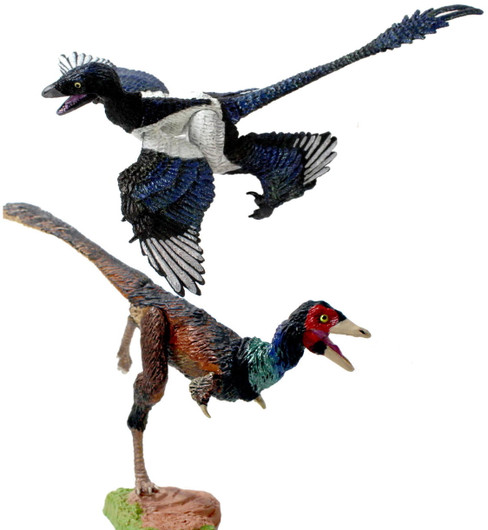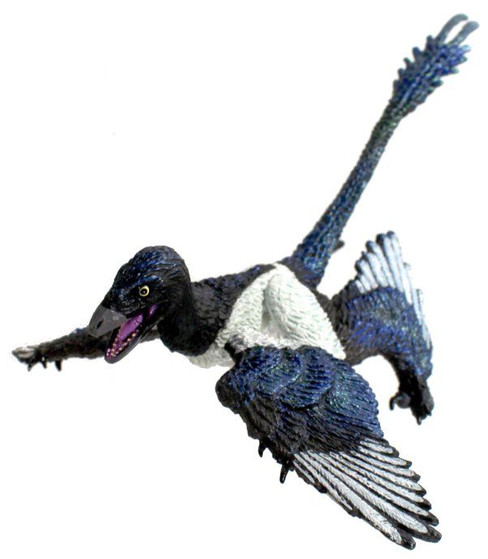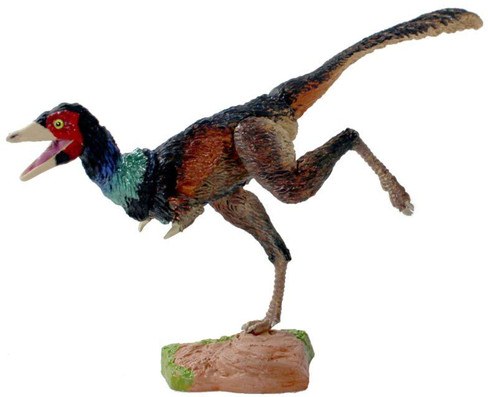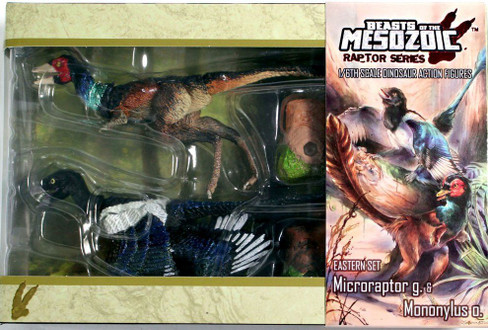Beasts of the Mesozoic Raptor Eastern 2-Pack
Beasts of the Mesozoic Raptor Eastern 2-Pack Manufacturer Information:
Microraptor gui (little thief ) was a small, four-winged bird-like dinosaur from Early Cretaceous Liaoning, China. It is known from numerous well-preserved fossil specimens, providing important evidence about the evolutionary relationship between birds and dinosaurs. Having long pennaceous feathers on the arms, tail and legs, paleontologists speculated that it glided using all four limbs for lift. Later studies suggest that Microraptor was also capable of powered flight.
Mononykus olecranus (one claw ) was a theropod dinosaur from Late Cretaceous Mongolia. This nocturnal hunter had long, skinny legs and probably ran at high speeds in the open flood plain habitat. It's small skull and pointy snout housed small sharp teeth, likely for eating insects and small lizards and mammals.
Each set features 2 raptor figures, each approximately 6? long with 7 points of articulation and includes two bases, multiple posing rods and attachments, collectible trading card, and unique background display insert. Packaging features red-foil printing and art by Shannon Beaumont.
Recommended for ages 15 and up (contains small parts)
Mononykus Information:
Mononykus is an extinct genus of small theropod dinosaur that lived during the Late Cretaceous period, approximately 75 million years ago. The name "Mononykus" comes from the Greek words "monos" (meaning single) and "onyx" (meaning claw), referring to its unique feature of having a single large claw on each of its hands. It is classified within the Alvarezsauridae family, a group of small, bird-like dinosaurs.
Here are some key features and information about Mononykus:
Size: Mononykus was relatively small, measuring about 1.2 meters (4 feet) in length.
Fossils: The first fossil remains of Mononykus were discovered in Mongolia's Gobi Desert in the 1990s. The incomplete skeletal findings primarily include a well-preserved pair of arms with the distinctive large claws and some associated bones.
Adaptations: Mononykus is best known for its unique forelimbs, which had one unusually large, highly specialized claw on each hand. These claws were likely used for digging and possibly for accessing food in burrows, similar to modern-day anteaters. It is believed that Mononykus was an excellent burrower, and this behavior likely played a significant role in its hunting and survival strategies.
Lifestyle: Due to its adaptations for digging and the presence of gastroliths (gastroliths are stones swallowed by some dinosaurs to aid in the breakdown of food in their stomachs), scientists speculate that Mononykus might have been insectivorous, feeding on small insects and other invertebrates found in the ground.
Feathers: Like many other small theropod dinosaurs, Mononykus is thought to have been covered in feathers. The presence of feathers in Alvarezsaurids is supported by fossil evidence from other members of this dinosaur group.
Behavior: Based on its anatomy and lifestyle, scientists believe that Mononykus was a solitary, ground-dwelling dinosaur that relied on its digging abilities to find food and potentially escape from predators.
Phylogenetic Placement: Mononykus is part of the Alvarezsauroidea, a group of small, bird-like dinosaurs characterized by their specialized claws, long legs, and reduced forelimbs. They are often considered to be closely related to birds, though their exact relationship is still a subject of research and debate.
Hand Painted. Product Material: PVC
Product Code: #60002
by Beasts of the Mesozoic


















